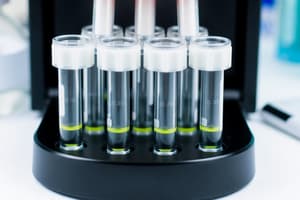Podcast
Questions and Answers
What does ELISA stand for?
What does ELISA stand for?
Enzyme-Linked Immunosorbent Assay.
What are ELISA assays used for in labs?
What are ELISA assays used for in labs?
To determine if a particular antibody is present in a patient's blood sample.
What test can be used to determine whether a patient has an infectious or autoimmune disease?
What test can be used to determine whether a patient has an infectious or autoimmune disease?
An ELISA test.
What does a positive result indicate?
What does a positive result indicate?
The watery fluid of the blood is called?
The watery fluid of the blood is called?
Once isolated, the secondary antibody can be?
Once isolated, the secondary antibody can be?
What happens when the appropriate chemical (substrate) is added?
What happens when the appropriate chemical (substrate) is added?
How is the test quantified?
How is the test quantified?
What does the amount of color reflect?
What does the amount of color reflect?
What is systemic lupus erythematosus (SLE)?
What is systemic lupus erythematosus (SLE)?
What are the four steps of an ELISA protocol?
What are the four steps of an ELISA protocol?
What does a centrifuge do?
What does a centrifuge do?
What are you preparing in step 2 and why are there three different solutions?
What are you preparing in step 2 and why are there three different solutions?
What has the ELISA plate been pretreated with and why?
What has the ELISA plate been pretreated with and why?
What is the positive control?
What is the positive control?
What is a primary antibody?
What is a primary antibody?
What is the negative control?
What is the negative control?
Why is it necessary to have a positive and a negative control?
Why is it necessary to have a positive and a negative control?
Why incubate the plate in step 5?
Why incubate the plate in step 5?
Why wash the plate?
Why wash the plate?
What is a secondary antibody?
What is a secondary antibody?
What is the attached enzyme in this assay?
What is the attached enzyme in this assay?
What is the specific substrate for HRP and what color does it produce?
What is the specific substrate for HRP and what color does it produce?
How can the yellow color be quantitatively measured, and at what wavelength?
How can the yellow color be quantitatively measured, and at what wavelength?
What do the results indicate?
What do the results indicate?
How is this same test used to test for the presence of HIV?
How is this same test used to test for the presence of HIV?
Flashcards are hidden until you start studying
Study Notes
ELISA Overview
- Stands for Enzyme-Linked Immunosorbent Assay, a common laboratory technique.
- Used to determine the presence of specific antibodies in a blood sample.
- Can diagnose infectious or autoimmune diseases.
ELISA Results Interpretation
- A positive result indicates an antibody is present, suggesting the person has the disease.
- The color intensity produced in the test correlates with the concentration of the antigen.
Serum and Controls
- Serum is the watery fluid extracted from blood after centrifugation.
- Positive control: anti-DNA primary antibody.
- Negative control: buffer to ensure reliability of results.
ELISA Steps
- Step 1: Samples are bound to a support and centrifuged to separate phases.
- Step 2: Different dilutions of samples are prepared for accurate antibody level determination.
- Step 3: Primary antibody is added to bind to the antigen; excess is washed away.
- Step 4: Secondary antibody-conjugate is added, allowing for detection.
- Step 5: Incubation ensures proper interaction between antibodies and antigens.
- Step 6: Plate washing removes unbound antibodies.
- Step 7: Secondary antibody, from a different species, is added along with HRP enzyme.
Significance of Color Change
- Substrate for HRP is ABTS, producing a yellow color which can be measured.
- Color is quantitatively analyzed at a wavelength of 414 nanometers.
Application for Disease Testing
- Systemic lupus erythematosus (SLE) is an autoimmune condition detected via ELISA.
- For HIV testing, a similar ELISA protocol can be followed with different reagents.
Patient Results Interpretation
- Results for hypothetical patients indicate likely disease presence:
- Patient A: Likely has SLE/HIV.
- Patient B: Unlikely to have SLE/HIV, further testing needed.
- Patient C: Probably does not have SLE/HIV.
Studying That Suits You
Use AI to generate personalized quizzes and flashcards to suit your learning preferences.




